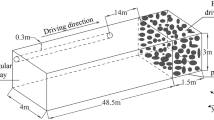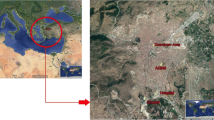Abstract
A three dimensional diffusion model has been developed for computing the concentration of PM10 from Kerman Cement Plant, Iran. This model incorporates source-related factors, meteorological factors, surface roughness, and settling particles to estimate pollutant concentration from continuous sources. The study focused on the local environmental impact of Kerman Cement Plant. The performance of the model was found to be in good agreement with measured data; the average absolute percent deviation is 25.53%. In addition, the result of this modeling shows that the PM10 concentration in the ambient air at distances of about 600–1,400 m from the stacks is higher than the WHO guidelines of an annual average of 260 μg/m3.
Similar content being viewed by others
References
Baroutian, S., Mohebbi, A., & Soltani Goharrizi, A. (2006). Measuring and modeling particulate dispersion: A case study of Kerman Cement Plant. Journal of Hazardous Materials 136, 468–474.
Canepa, E., & Ratto, C. F. (2003). Algorithms to simulate the transport of pollutant elements: A model validation exercise and sensitivity analysis. Environmental Modeling and Software, 18, 365–372.
Crawford, M. (1976). Air pollution control theory. New York: McGraw - Hill Book Company.
Goyal, P., & Sidhartha (2004). Modeling and monitoring of suspended particulate matter from Badarpur thermal power station, Delhi. Environmental Modeling and Software, 19, 383–390.
Lettau, H. (1959). Wind profile, surface stress and geotropic drag coefficient, Advances in geophysics, Vol.6, (pp 241–259). New York: Academic Press.
Lettau, H. (1969). Note on aerodynamic roughness-parameter estimating on basis of roughness-element description. Journal of Applied Meteorology, 8.
Monin, A. S., & Obukhov, A. M. (1954). Basic laws of turbulent mixing in the surface layer of the atmosphere. Tr. Geofiz. Inst., Akad. Nauk SSSr, 24, 1963–1967.
Moreira, D. M., Vilhena, M. T., Buske, D., & Tirabassi, T. (2006). The GILTT solution of the advection - diffusion equation for an inhomogeneous and nonstationary PBL. Atmospheric Environment, 40, 3186–3194.
Olcese, L. E., & Toselli, B. L. (2005). Development of a model for reactive emissions from industrials stacks. Environmental Modeling and Software, 20, 1239–1250.
Patankar, V. S. (1980). Numerical heat transfer and fluid flow. New York: McGraw Hill Book Company.
Peters, L. K., & Klinzing, G. E. (1971). Effect of variable diffusion coefficients and velocity on the dispersion of pollutants. Atmospheric Environment, 5(7), 497–504.
Ragland, K. W., & Dennis, R. L. (1975). Point source atmospheric diffusion model with variable wind and diffusivity profiles. Atmospheric Environment, 9(2), 175–189.
Turner, D. B. (1970). Workbook of atmospheric dispersion estimates, revised sixth printing, Jan. 1973. Office of Air Programs Publications No. AP–26. U.S. Department of Health, Education and Welfare, National Air Pollution Control Administration, Cincinnati, Ohio.
USEPA (1986). Guideline on air quality models. EPA-450/2-78-027R, July.
USEPA (1996). Requirements for preparation, adoption and submittal of implementation plans; Final rule, Republishing the US EPA Guideline on Air quality models, 61 Fed. Reg. 41837–41894.
Author information
Authors and Affiliations
Corresponding author
Rights and permissions
About this article
Cite this article
Mohebbi, A., Baroutian, S. Numerical Modeling of Particulate Matter Dispersion from Kerman Cement Plant, Iran. Environ Monit Assess 130, 73–82 (2007). https://doi.org/10.1007/s10661-006-9447-7
Accepted:
Published:
Issue Date:
DOI: https://doi.org/10.1007/s10661-006-9447-7




